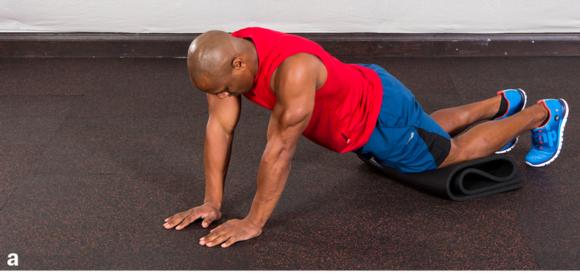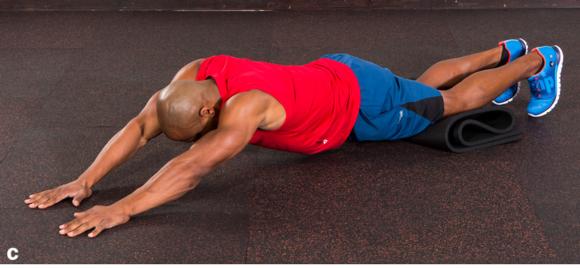Arm Walkout and Medicine-Ball Walkout
This is an excerpt from Building Muscle and Performance by Nick Tumminello.
Arm Walkout



Setup
Assume a kneeling position with your hands flat on the floor just above your shoulders and your arms straight under your shoulders (see figure a). Your torso should form a fairly straight line from your head to your knees. You may also need to place a pad, pillow, or folded towel under your knees for comfort.
Action
Walk your arms out in front of you as far as possible without allowing your lower back to extend beyond the starting position (see figures b and c). Reverse the motion, walking your hands back so that they end up just in front of your shoulders.
Coaching Tips
- Keep your body in a straight line throughout; do not allow your hips or head to sag toward the floor.
- Squeeze your glutes tightly each time that you walk your hands out to the long position.
- Walk your arms out only as far as you can without feeling discomfort in your lower back.
Medicine-Ball Walkout


Setup
Assume a kneeling position with your hands on the top of a rubber or sand-filled medicine ball just above your shoulders and your arms straight (see figure a). Your torso should form a fairly straight line from your head to your knees. You may also need to place a pad, pillow, or folded towel under your knees for comfort.
Action
Roll the ball out in front of you by walking with your arms in hand-over-hand fashion as far as possible without allowing your lower back to extend beyond the starting position (see figure b). Reverse the motion, rolling the ball back toward you by walking your hands back so that they end up just in front of your shoulders.
Coaching Tips
- Keep your body in a straight line throughout; do not allow your hips or head to sag toward the floor.
- Squeeze your glutes tightly each time that you walk your hands out to the long position.
- Walk your arms out only as far as you can without feeling discomfort in your lower back.
- If using a rubber medicine ball (the kind found at most gyms), choose one that is fully inflated and large enough - at least 8 pounds (3.5 kg) - to accommodate both of your hands.
- If using a sand-filled ball, you can make the exercise harder by using a heavier ball.
Learn more about Building Muscle and Performance.
More Excerpts From Building Muscle and PerformanceSHOP

Get the latest insights with regular newsletters, plus periodic product information and special insider offers.
JOIN NOW
Latest Posts
- Authenticity was key to McKinney’s NIL success
- AI—A new tool for sport PR pros
- Essential skills for sport PR practitioners
- Employ these tactics when pitching a story to the media
- How does ergonomic analysis and intervention enhance safety and reduce injury risk?
- Common movement patterns in competitive cycling


